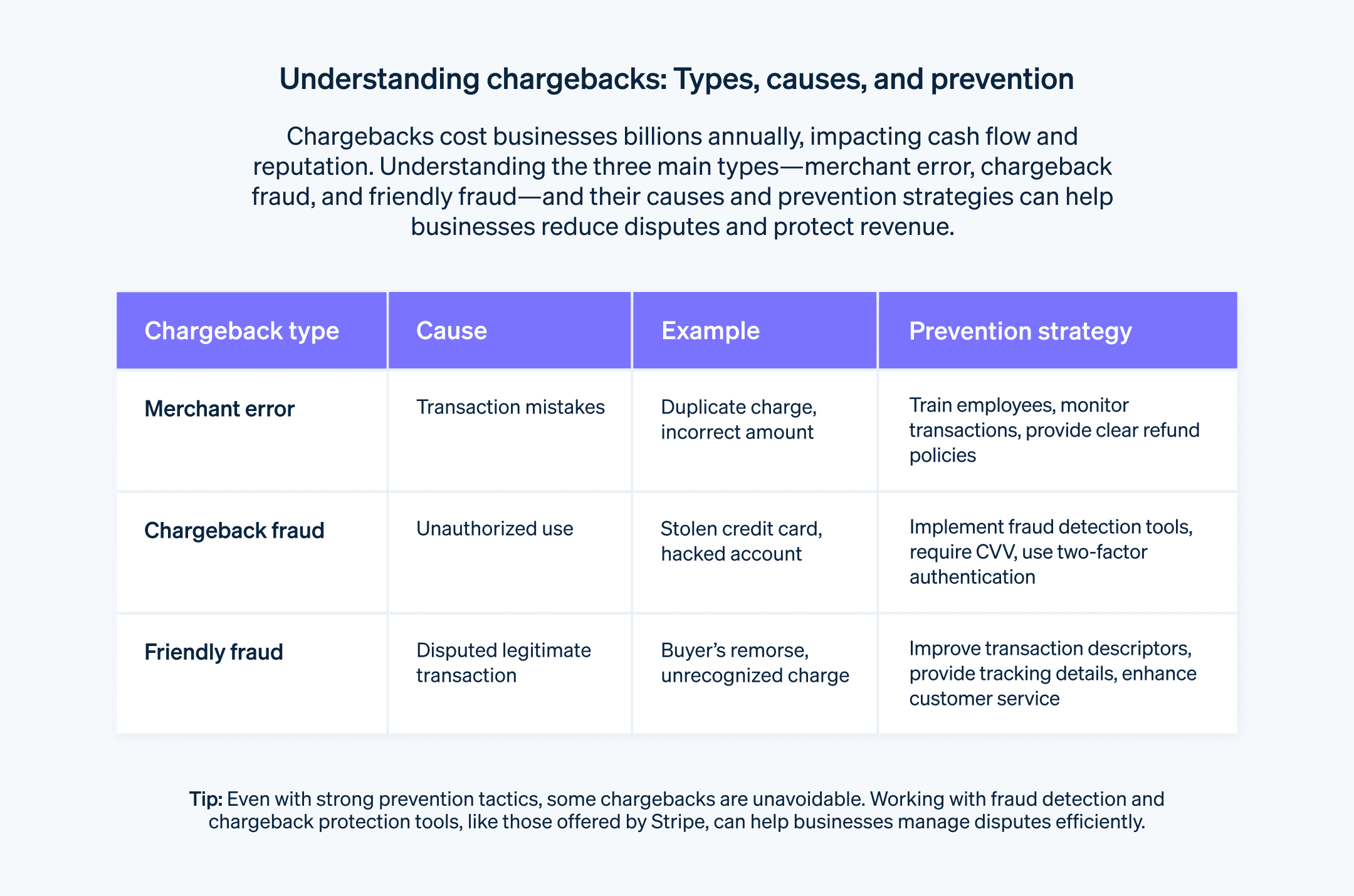拒付每年以 20% 的速度增长,给企业造成数十亿美元的收入损失。这些交易纠纷有可能扰乱企业的现金流,损害其声誉,并带来额外的财务负担。
识别不同类型拒付的细微差别并实施有效的预防策略,可以帮助企业保持客户满意度,为可持续增长奠定坚实的基础。
目录
- 什么是撤单?
- 拒付类型
- 商家错误拒付
- 拒付欺诈
- 友好欺诈
- 商家错误拒付
- 如何防止拒付
什么是撤单?
拒付 是持卡人或金融机构发起的金融交易撤销。通常情况下,拒付被用作一种消费者保护机制,当信用卡或借记卡交易 出现争议或欺诈活动 时,该机制就会发挥作用。发生拒付时,最初从持卡人账户转入企业账户的资金将退还给持卡人。
持卡人发起拒付的原因可能有很多,包括:
未经授权的交易
如果持卡人发现自己的账户上有未经授权或不认可的交易,他们可以请求拒付,对这笔扣款提出异议。欺诈活动
拒付通常用于处理欺诈案件,即持卡人的账户信息被盗或在未经其同意的情况下被使用。对商品或服务不满意
如果客户对他们订购的商品或服务的质量不满意,他们可能会发起拒付以获得退款。商品或服务未送达
如果持卡人支付了商品或服务的费用,但未按承诺收到商品或服务,他们可能会请求拒付以收回资金。
拒付可能会给企业带来严重的财务后果。除了损失有争议的金额(退还给持卡人)外,企业还可能产生与拒付流程相关的额外费用和罚款。过多的拒付会给企业的声誉造成负面影响,增大支付处理商的审查力度,甚至导致企业无法接受银行卡付款。
拒付类型
虽然每种拒付背后的机制都是一样的,但发生拒付的原因却各不相同。了解这些区别是采取正确措施防止拒付并在发生拒付时有效应对的重要一步。以下是影响企业的拒付的主要类别:
商家错误拒付
商家错误拒付是指企业在交易过程中出现错误,导致持卡人对扣款提出异议。这些错误可能是人为错误,也可能是技术问题。由于企业对错误负有责任,持卡人会发起拒付以纠正这种情况。
以下是一些企业错误拒付示例:
重复收费
在这种情况下,企业不小心多次处理同一笔交易,为单次购买向客户多次收费。当持卡人发现其账户对账单上有重复收费时,他们可以发起拒付,对额外费用提出异议并要求退款。
例:客户在网上商店购物,但在结账过程中遇到错误。假定交易失败,他们重新尝试购买,结果信用卡对账单上出现了同一商品的两笔费用。
收费金额不正确
如果商家故意或错误地收取了不正确的交易金额,持卡人可以通过拒付提出异议。这种情况可能是由于定价错误、错字或交易过程中的沟通不当造成的。
例:客户同意以 50 美元的价格购买产品,但企业错误地收取了 500 美元的费用。当客户在信用卡对账单上发现多收了这笔费用时,他们可以发起拒付以纠正错误。
不遵守卡组织规则
卡组织(如 Visa、Mastercard 和美国运通)都有具体的规则和规定,企业在交易过程中必须遵守。如果商家未能遵守这些规则,持卡人可以发起拒付。违规行为包括未获得适当授权、未遵循适当的退款程序或违反卡组织的指导原则。
例:某企业未能获得交易的适当授权,未经持卡人同意就从其账户中扣款。持卡人发现这笔未经授权的扣款后,可以发起拒付,对交易提出异议。
在业务错误拒付中,企业有责任纠正错误并与持卡人解决争议。企业应采取措施尽量减少交易过程中的错误,保持准确的记录,并及时处理任何客户投诉或差异,以避免这些拒付。
拒付欺诈
当持卡人的账户遭到入侵,第三方在持卡人不知情或未经其同意的情况下进行未经授权的交易时,就会发生拒付欺诈。在这些情况下,持卡人不对欺诈性收款负责,他们可以发起拒付以收回他们的资金。以下是一些拒付欺诈示例:
卡被盗
当持卡人的实体卡被盗并且小偷使用它进行未经授权的交易时,持卡人可以向其发卡机构报告欺诈性收款并发起拒付。
例:小偷偷了某人的钱包,里面有他的信用卡。小偷使用被盗的卡在各种商店购物。一旦持卡人发现该卡被盗并用于未经授权的扣款,他们就会联系发卡机构报告盗窃行为,并对欺诈性交易发起拒付。
账户入侵
如果持卡人的账户信息是通过黑客或网络钓鱼技术获得的,诈骗分子可以使用被盗信息进行未经授权的购买。持卡人可以通过发起拒付来对这些欺诈性收款提出异议。
例:持卡人成为网络钓鱼 诈骗的受害者,在不知情的情况下将其账户详细信息提供给诈骗分子,诈骗分子随后访问持卡人的账户并进行未经授权的在网上购物。持卡人一旦发现欺诈活动,就会通知发卡机构,该机构帮助持卡人发起拒付以撤销扣款。
伪造卡
诈骗分子有时会使用被盗的账户信息创建伪造卡。这些卡类似于真正的信用卡,但不是由合法的金融机构发行的。诈骗分子使用这些伪造卡进行未经授权的购买,合法持卡人可以通过拒付对此提出异议。
例:诈骗分子获取持卡人的账户信息,并使用被盗的详细信息创建伪造卡。然后,诈骗分子使用伪造卡在不同的企业购物。一旦持卡人发现其账户对账单上有未经授权的扣款,他们就会联系发卡机构并发起拒付,对欺诈性交易提出异议。
在真正的欺诈拒付中,持卡人被视为欺诈活动的受害者。发卡机构有责任调查欺诈行为,撤销未经授权的扣款,并采取必要措施防止进一步的欺诈性交易。持卡人应及时向发卡机构报告任何未经授权的活动,以确保及时解决问题,并保护自己免于承担欺诈性收款的责任。
友好欺诈
友好欺诈,也称为拒付欺诈 或第一方欺诈,是指持卡人故意或由于误解或争议而对合法交易发起拒付。与真正的欺诈拒付不同,友好欺诈意味着持卡人发起拒付,通常没有正当理由。以下是一些友好欺诈的例子:
买家反悔
在这种情况下,持卡人购买了商品,但后来后悔了,或者决定不再需要该产品或服务。持卡人没有按照企业的退货或退款政策办理退款,而是发起了拒付,即使购买是合法的,产品或服务也没有任何问题。
例:持卡人购买了昂贵的电子设备,但几天后改变了主意。他们没有走正规的退货流程,而是对收费提出异议并发起拒付以获得退款。
未经授权的家庭成员
当持卡人账户的家庭成员或授权用户在持卡人不知情或未同意的情况下购物时,可能会发生友好欺诈。在这种情况下,持卡人对收款提出异议,声称自己没有授权该交易。
例:持卡人的十几岁子女是该账户的授权用户,在未经许可的情况下购物。当持卡人在他们的对账单上注意到这笔收费时,他们会通过拒付提出异议,声称自己没有授权该交易。
数码商品
友好欺诈在数字商品(例如数字下载、订阅 或在线服务)中尤为普遍。为了获得退款,即使持卡人已经收到或使用了服务,他们也可能声称自己没有收到商品,或者收到的商品与广告宣传的不一样。
例:持卡人订阅了在线流媒体服务,享受了几个月的内容,然后发起拒付,声称他们从未收到过该服务。
对于企业来说,打击友好欺诈是一项挑战,因为这通常涉及持卡人根据主观主张提出争议。但是,企业可以采取一些措施来预防、检测和应对这些类型的争议。

如何防止不同类型的拒付
不同类型的拒付需要不同的预防策略。虽然大多数企业无论采取何种预防措施都会产生一定数量的拒付,但您并非对拒付束手无策。如需更深入地了解如何防止拒付,请阅读我们的指南。
以下是企业可以采取的一些重要步骤,以尽量减少各种类型的扣款。
防止企业错误拒付
防止企业错误拒付涉及实施强大的系统和实践,以更大限度地减少交易过程中的错误。通过关注准确性、沟通和客户满意度,企业可以减少因自身错误而导致的拒付次数。以下是一些防止企业错误拒付的有效策略:
精准的交易处理
培训员工
对您的员工进行支付处理系统和程序方面的培训。他们应该熟悉如何准确处理交易,包括如何验证支付信息、检查潜在错误以及获得适当的授权。实施质量控制措施
建立内部制衡机制,在处理交易之前对其进行审查。这可能涉及要求多个人验证交易细节的准确性,并确保正确输入所有必要的信息。
清晰透明的沟通
提供详细的产品描述
清楚地传达产品或服务的详细信息,包括功能、规格和限制,以避免潜在的误解。披露定价和费用
清楚地显示与交易相关的价格、费用和任何额外收款。避免可能导致客户混淆或不满的隐藏或不明确的定价做法。透明的退款和退订政策
使您的退款和退订政策易于访问,并明确说明客户在需要申请退款或取消订单时应遵循的程序。
及时的客户服务和争议解决
提供便捷的客户支持
让客户可以通过手机、电子邮件或实时聊天等各种渠道轻松联系您的客户支持团队。及时响应客户的查询、疑虑和争议,以便在问题升级并导致拒付之前解决问题。友好解决纠纷
积极与客户合作,解决他们的疑虑或投诉。尽可能理解和灵活处理,提供公平的解决方案,优先考虑客户的满意度和忠诚度。
健全的订单履行和交付
准确的订单处理
确保准确履行订单,从选择正确的产品到安全包装,包括所有必要的组件或配件。可靠的运输和跟踪
使用信誉良好的运输方式并向客户提供跟踪信息,以便他们监控发货进度,从而减少因未交付而发生争议的可能性。
文档和记录保存
- 维护交易记录
保留所有交易的全面记录,包括订单详细信息、客户信息、交货证明和任何相关通信。这些记录可以作为发生争议或拒付时的证据,并有助于及时准确地解决任何问题。
支付系统监控
监控技术问题
定期检查和监控您的支付系统,以发现任何可能导致多收费用、重复收费或其他不准确之处的技术故障或错误。进行定期审计
进行内部审计,以识别和解决交易过程中的潜在错误或差异。
通过实施这些策略,企业可以更大限度地减少交易过程中的错误,并减少因业务错误而导致拒付的可能性。密切关注准确性、透明度、客户满意度和积极主动的问题解决方案,有助于为客户提供良好的体验,降低拒付风险。
防止拒付欺诈
要防止真正的拒付欺诈,就要采取措施识别和防止诈骗分子进行未经授权的交易。虽然不可能完全杜绝真正的欺诈行为,但企业可以采取措施尽量减少欺诈行为,包括:
强大的欺诈检测系统
使用欺诈预防工具
采用先进的欺诈检测系统,利用机器学习算法和行为分析来识别潜在的欺诈性交易。这些系统可以标记可疑模式和高风险交易,以便进一步审查。采用地址验证
使用地址验证服务 (AVS),验证持卡人在交易过程中提供的账单地址。地址不匹配可能表明存在欺诈行为。使用银行卡验证方法
要求客户在交易过程中提供银行卡验证码 (CVV),该代码印在银行卡背面。这增加了一层额外的身份验证,有助于确保客户实体卡的安全。
强客户认证
实施双重身份验证
要求客户通过一层额外的身份验证,例如提供发送到其注册移动设备的一次性密码,以便在高风险或看似可疑的交易期间验证其身份。实施生物识别身份验证
探索生物识别认证方法,例如指纹或面部识别,用于在通过移动设备或其他兼容平台进行的交易期间进行客户验证。
交易监控和风险评分
监控交易模式
监控交易数据和客户行为,以发现任何异常或偏离正常购买模式的模式。交易量异常、短时间内从不同地理位置进行多笔交易或购买模式不一致都可能表明存在欺诈活动。实施风险评分
根据交易金额、位置、客户历史记录和产品类型等不同因素为交易分配风险评分。在批准高风险交易之前,请对其进行额外的验证或审查。
教育和培训员工
对员工进行防欺诈培训
帮助员工了解常见的欺诈指标、警告信号和识别潜在欺诈性交易的最佳实践。确保他们了解在怀疑欺诈时应采取哪些步骤。随时了解欺诈趋势
通过定期培训课程和行业资源,让团队了解最新的欺诈技术、趋势和新兴威胁。这些知识可帮助他们保持警惕并适应不断变化的欺诈策略。如果您与具有卓越欺诈检测和预防能力的支付处理提供商(如 Stripe)合作,他们将为您承担这一责任。
安全的支付基础设施
维护安全系统
确保您的支付基础设施是最新的,并遵守数据安全的行业标准。使用安全的支付网关并遵循支付卡行业数据安全标准 (PCI-DSS) 指南,以保护持卡人数据免遭未经授权的访问。鼓励客户采取安全措施
让您的客户了解维护强密码的重要性。定期监控其账户活动,及时向发卡机构 报告任何可疑交易。
与支付处理商和网络合作
这些策略使企业能够增强其欺诈预防能力,降低真实欺诈拒付的可能性。但是,在预防欺诈和提供顺畅的客户体验之间取得平衡非常重要。强有力的欺诈预防措施不应为合法客户造成不必要的障碍。
防止友好欺诈拒付
防止友好欺诈可能具有挑战性,因为这种类型的拒付意味着持卡人故意利用拒付流程。但是,企业可以采取某些措施更大限度地减少友好欺诈,包括:
清晰透明的沟通
在您的网站上提供详细的产品描述、服务条款、退款政策和送货/运输信息。确保持卡人清楚地了解他们购买的商品和预期,以尽量减少可能导致无端拒付的误解。可靠的客户服务
建立可靠的客户支持渠道,例如电子邮件、电话和实时聊天,以及时解决任何问题或争议。及时、高效地响应客户查询和投诉有助于在问题升级为拒付之前解决问题。出色的客户服务可以阻止持卡人将拒付作为他们的首要行动方案。订单确认和交货跟踪
在客户购买后立即向他们发送自动订单确认电子邮件,包括订单号、产品描述和运输信息等详细信息。为已发货的订单提供跟踪号,以便客户可以监控交货状态。这些措施有助于建立购买和交付证据,使持卡人更难谎称未收到货物。增强的交易描述符
确保您的银行卡对账单上的企业名称或交易描述符易于持卡人识别。清晰易辨的描述符 可以减少客户因无法识别对账单上的交易而发起拒付的可能性。客户身份验证
实施额外的安全措施,在交易过程中验证持卡人的身份。这可能包括请求 CVV 代码、实施双重身份验证或使用高级欺诈检测系统来检测可疑或高风险交易。这些措施有助于妨碍诈骗分子,使未经授权的个人更难进行欺诈性购买。证据收集
维护交易、客户互动、订单确认、运输信息和任何其他相关数据的详细记录。如果发生争议或拒付,您可以使用此文档协助证明扣款是合法的,并可能反驳无根据的拒付。拒付再请款
如果您认为拒付不合理或属于友好欺诈类别,请考虑通过再请款 过程对拒付提出异议。提供所有相关证据,例如交易记录、通信日志和收货信息来支持您的案件。详细了解 Stripe 如何与企业合作处理再请款流程。数据分析和模式识别
监控交易数据并寻找可能表明友好欺诈的模式或异常情况。分析客户行为、购买记录和其他相关数据以识别危险信号。及早识别可疑模式有助于您采取强有力的有效措施来防止拒付。由于其中大部分跟踪和报告都内置于 Stripe 为企业提供的解决方案中,因此与 Stripe 合作可简化企业的工作范围。
虽然这些策略有助于减少友好欺诈的发生,但重要的是要记住,友好欺诈往往是企业现有不足或低效的产物,例如未能与客户沟通条款和退货政策,以及客户服务不到位。如果不考虑可能导致拒付的更广泛条件,企业就无法成功管理拒付。详细了解 Stripe 的拒付保护。
本文中的内容仅供一般信息和教育目的,不应被解释为法律或税务建议。Stripe 不保证或担保文章中信息的准确性、完整性、充分性或时效性。您应该寻求在您的司法管辖区获得执业许可的合格律师或会计师的建议,以就您的特定情况提供建议。